
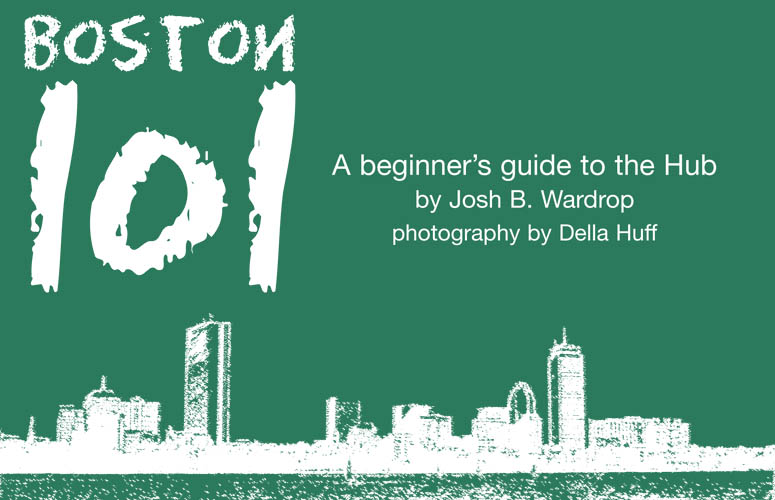
Believe it or not, there are actually some people who’ve never visited the historic, beautiful and always-exciting city of Boston—heck, you may even be one of those people yourself! Whether you’re in town for the first time dropping your son or daughter off at one of our many fine institutions of higher learning, or you’re a sports fan enamored from afar with the World Series champion Boston Red Sox or the AFC champion New England Patriots that’s come to take in a game, there’s a lot you should make time to see and do while in Beantown. Panorama offers some of the basics you’ll want to know as you embark upon a holiday in the Hub.
Welcome to
the Neighborhood
New York can keep its “boroughs”: Boston is
a city of neighborhoods, each one with its
own distinct identity and great reasons to
visit and spend time there. Here’s a quick
primer on some of Boston’s diverse ’hoods
and their claims to fame.
Allston-Brighton: Packed with bars and clubs, ethnic restaurants and cool shops, this youth-centric neighborhood (Boston University, Boston College and Harvard University all have campuses there) is one of Boston’s funkiest areas for nightlife. Popular with: College students, music lovers, barflies.
Back Bay: Gorgeous old brownstones stand among lovely tree-lined sidewalks, while just blocks away streets like Newbury and Boylston teem with beautiful people enjoying Boston’s best shopping and most popular restaurants. Popular with: Ladies who lunch, fashionistas, people-watchers.
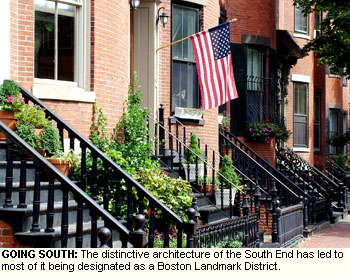 Beacon Hill:
This historic neighborhood still
boasts cobblestone streets and old-fashioned
gaslamps, and is nestled in the shadows of
the State House and Suffolk University. It’s
a place where lawmakers mingle with law
students while folks with money shop in
swanky boutiques on charming Charles Street.
Popular with: Senators, bluebloods, antiques
dealers.
Beacon Hill:
This historic neighborhood still
boasts cobblestone streets and old-fashioned
gaslamps, and is nestled in the shadows of
the State House and Suffolk University. It’s
a place where lawmakers mingle with law
students while folks with money shop in
swanky boutiques on charming Charles Street.
Popular with: Senators, bluebloods, antiques
dealers.
The Fenway: Largely associated with Fenway Park, this Boston neighborhood also boasts some of the city’s top cultural institutions, including the Museum of Fine Arts and the Isabella Stewart Gardner Museum (refer to museum listings), and is close to much of the city’s lushest greenspaces, proving that the Fenway has tons more to offer than just peanuts and Cracker Jack. Popular with: Red Sox fans, art students, joggers.
North End: Boston’s oldest neighborhood is home to generations of Italians and a staggeringly large number of delicious Italian restaurants, bakeries and cafes. It’s one of the most-visited parts of Boston, thanks to its charming Old World vibe and all that amazing food. Popular with: Pasta lovers, tourists, girls’ nights out, beefy guys who look like extras from “The Sopranos.”
 South End: Perhaps the
city’s trendiest neighborhood, this longtime
artists’ enclave and gay-friendly
neighborhood has opened up to new
demographics—including increasing numbers of
families—in recent years because of an
influx of acclaimed restaurants, stylish
shopping and arts and theatre venues.
Popular with: Foodies, dog owners, artists.
South End: Perhaps the
city’s trendiest neighborhood, this longtime
artists’ enclave and gay-friendly
neighborhood has opened up to new
demographics—including increasing numbers of
families—in recent years because of an
influx of acclaimed restaurants, stylish
shopping and arts and theatre venues.
Popular with: Foodies, dog owners, artists.
Hub
Landmarks
If you went to San Antonio
for the first time, you’d visit the Alamo.
In Philadelphia, you’d check out the Liberty
Bell. Well, Boston has a few must-see spots
of its own—ranging from historic edifices
where the nation we know today was forged to
a subterranean bar where “everybody knows
your name.”
The Freedom Trail: One of Boston’s most popular activities for visitors, this 2.5-mile long trail encompasses 16 historic sites that were vital and significant to the birth of our free nation. Beginning on Boston Common, the Freedom Trail (marked right on the ground as, alternately, a painted red line or a double line of red brick) winds through ritzy Beacon Hill past sites like the gold-domed State House and Park Street Church, into downtown Boston past the Old Granary Burying Ground and the Old South Meeting House, through the historic North End—home to the Paul Revere House and the Old North Church—and finally ending in Charlestown at the USS Constitution. Refer to freedom trail listings.
Boston Common: A green oasis smack-dab in the center of the city, Boston Common during the summer is a vibrant mix of joggers, families, and sightseers. A trip to the Common can entail strolling to the nearby Public Garden, where you can ride on the city’s famed avian-shaped peddle-crafts, the Swan Boats (refer to sightseeing listing), or let your little ones sit on the bronze statues of the Mallard family from the Boston-set children’s classic Make Way for Ducklings. Or satisfy your athletic side on the Common’s tennis courts or softball diamond, and, on hot days, dip your tootsies in the Frog Pond’s wading pool and spray fountain.
Faneuil Hall: This spot on the Freedom Trail was historically a meeting hall where fierce patriotic speeches were heard. Today, though, it’s not political firebrands that flock there but fans of shopping, dining and entertainment. Faneuil Hall Marketplace boasts Quincy Market, a massive indoor food court, as well as indoor and outdoor shops and kiosks and top restaurants like Kingfish Hall and Dick’s Last Resort (refer to restaurant listing). Street performers during the day give way to an active nightlife scene after dark, with dozens of bars and clubs attracting multitudes of revelers.
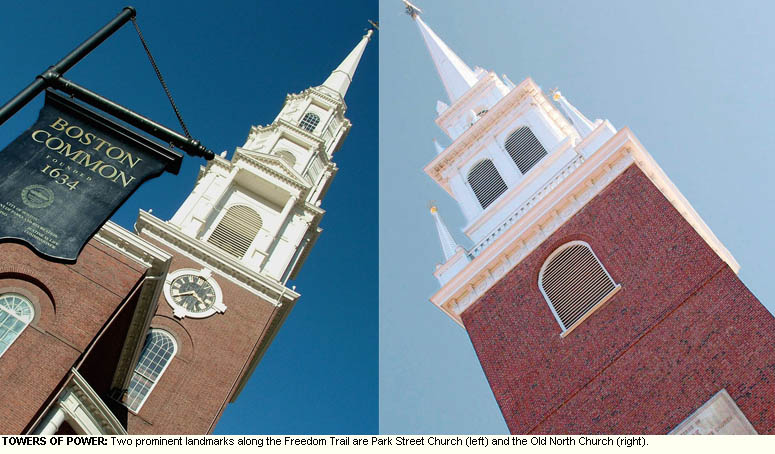
Fenway Park: Opened in 1912, the oldest ballpark in the Major Leagues is also one of the most popular, thanks to the seemingly nationwide love affair with the Boston Red Sox (don’t worry, Yankees fans, we know you still hate us). The Sox have sold out every game for the last several years, but folks still flock to the area around Lansdowne Street and Yawkey Way to drink in the pre- and post-game excitement at popular sports bars or to take Fenway Park Tours (refer to sightseeing listing), which get people up close to where luminaries like Ted Williams, Wade Boggs and Manny Ramirez once played.
Cheers: Upon opening in 1969 it was known as the Bull & Finch Pub, but after the producers of the NBC sitcom “Cheers” used the bar’s exterior in the show’s opening credits, the bar became, for all intents and purposes, “Cheers” to the literally thousands of visitors who made a point of eating and drinking there when they came to Boston. (The bar officially changed its name in the ’90s.) Be warned: the inside doesn’t resemble the bar where Sam and Woody served up so many frosty brews, but there’s plenty of “Cheers” memorabilia to be had, and you can always order a “Giant Norm Burger” off the menu.
George
Washington Ate Here
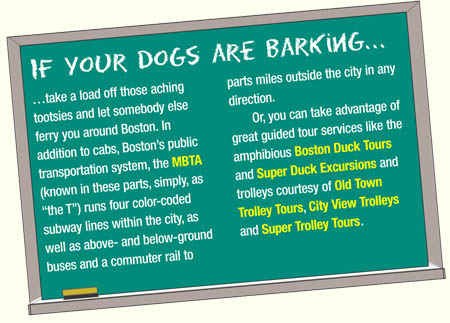 Well, maybe not—but that doesn’t change the
fact that Boston, befitting a town so rich
in history, has a handful of legendary
restaurants operating today that do go back
quite a ways. If you want to enjoy a meal of
truly historic proportions while in Boston,
take a taste of some of these
oldies-but-goodies.
Well, maybe not—but that doesn’t change the
fact that Boston, befitting a town so rich
in history, has a handful of legendary
restaurants operating today that do go back
quite a ways. If you want to enjoy a meal of
truly historic proportions while in Boston,
take a taste of some of these
oldies-but-goodies.
The oldest-continually operating restaurant in the U.S. dating back to 1826, Ye Olde Union Oyster House (refer to restaurant listing), still draws tourists from around the world to sample the fantastic seafood and belly up to the oyster bar where Daniel Webster used to eat six plates of oysters at a sitting. Just a year younger is Durgin-Park (340 Faneuil Hall Marketplace, 617-227-2038), which still features traditional New England cuisine (i.e., heavy on seafood, broiled meats and boiled dinners) served by sassy, tart-tongued waitresses.
Lovers of German cuisine have eaten at Jacob Wirth (31-37 Stuart St., 617-338-8586) in the Theatre District since 1868, chowing down on Reubens, sauerbraten, wiener schnitzel and phenomenal German and Belgian beers. And Locke-Ober (refer to restaurant listing) may have changed with the times since the 1870s (chef/owner Lydia Shire couldn’t have eaten there in the old days—it was men only), but it still specializes in the sort of rich, classic dishes (including lobster Savannah, broiled scrod and rack of lamb) that discerning diners have savored for generations.
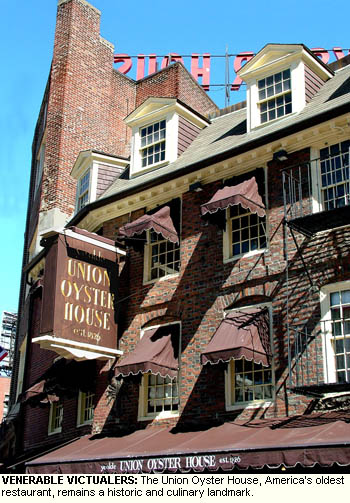 Walk
this Way
Walk
this Way
There’s plenty of reasons
why Boston’s been dubbed one the nation’s
best walking cities. It’s quite a manageable
size—often, two points that seem quite far
from each other on a map can be walked to in
a surprisingly short time. It’s very safe
and clean for a major metropolitan center,
and Boston is packed with beautiful
Colonial-era architecture that one tends to
miss whizzing by in a taxi or hurtling
underground via subway.
In recent years, Boston’s been able to
put its best foot even farther forward to
walking enthusiasts with a pair of new
scenic walking paths that have opened up
more parts of the city to pedestrian
traffic. The Harborwalk—a series of
connected walkways tracing a 47-mile stretch
of the Boston Harbor shoreline—has opened up
beautiful seaside views of boats on Boston
Harbor, gorgeous parks like Christopher
Columbus Waterfront Park and cultural
attractions like the Institute of
Contemporary Art and New England
Aquarium (refer to
museum listing
and
sightseeing listing) to strollers from historic Charlestown
all the way to the South Boston waterfront.
Meanwhile, the lovely Rose Kennedy
Greenway (named for the matriarch of
Massachusetts’ renowned political family) is
a 15-acre ribbon of public walkways and
vibrant, green park land created when the
Big Dig construction project converted the
above-ground Central Artery into an
underground tunnel. The Greenway connects
all the way from Chinatown to the North End,
and boasts spray fountains, park benches and
lovely grassy areas to play Frisbee or catch
a few rays while you ponder where to walk to
next.

back to homepage